To understand how the ketogenic diet works, lets take a look at how our bodies get energy. We’ve heard, all our lives about the nutritional 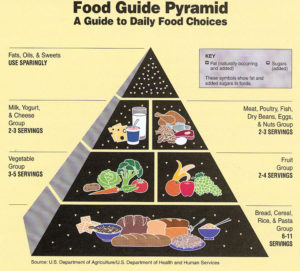 pyramid and how most of what you should eat is grain based followed closely by fruit and vegetables. I find it interesting that at the bottom of the nutritional pyramid, one of the sponsors is the US Department of Agriculture. Well, everything located on the bottom 2 tiers of the food pyramid, your body converts to glucose (sugar). So by eating what the government says you need, you support American agriculture, and flood your blood stream with sugar. In fact, the glycemic index of a bowl of “heart healthy” Grape Nuts (75) or Cheerios (74) without sugar, is higher than the table sugar (68) you might put on them. So what is the glycemic index? It is a scale that grades how quickly a food will “spike” your blood sugar. When your blood sugar is elevated, your pancreas releases insulin to combat the glucose in your blood. Your body will burn a considerable amount of that sugar as fuel, but the glucose your body doesn’t burn, the insulin will store as fat in your fat cells for later use. The problem is, that as long as insulin levels remain high, your body will not easily release the fat stored in the fat cells. When the blood glucose level is low, the body begins wanting fuel, but if the insulin level is still high the body won’t release the stored fat. If you’re on the Standard American Diet (SAD) which follows the nutritional pyramid and is based on carbohydrates; during these lows in blood sugar level, when insulin levels are high, the body is starving on a cellular level. If you don’t replenish the glucose by
pyramid and how most of what you should eat is grain based followed closely by fruit and vegetables. I find it interesting that at the bottom of the nutritional pyramid, one of the sponsors is the US Department of Agriculture. Well, everything located on the bottom 2 tiers of the food pyramid, your body converts to glucose (sugar). So by eating what the government says you need, you support American agriculture, and flood your blood stream with sugar. In fact, the glycemic index of a bowl of “heart healthy” Grape Nuts (75) or Cheerios (74) without sugar, is higher than the table sugar (68) you might put on them. So what is the glycemic index? It is a scale that grades how quickly a food will “spike” your blood sugar. When your blood sugar is elevated, your pancreas releases insulin to combat the glucose in your blood. Your body will burn a considerable amount of that sugar as fuel, but the glucose your body doesn’t burn, the insulin will store as fat in your fat cells for later use. The problem is, that as long as insulin levels remain high, your body will not easily release the fat stored in the fat cells. When the blood glucose level is low, the body begins wanting fuel, but if the insulin level is still high the body won’t release the stored fat. If you’re on the Standard American Diet (SAD) which follows the nutritional pyramid and is based on carbohydrates; during these lows in blood sugar level, when insulin levels are high, the body is starving on a cellular level. If you don’t replenish the glucose by 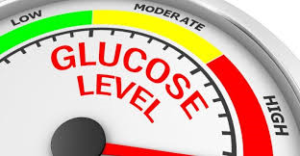 eating more carbohydrates the body begins to conserve energy by lowering metabolism and you get tired, if you do eat more carbohydrates the cycle repeats. Now this is a simplified scenario and is basic 8th grade health in one paragraph. I watched a video (I can’t remember where… it may have been in the documentary “Fat Head”) where a clinical research doctor says, “you can make anyone fat, all you have to do is give them enough insulin”.
eating more carbohydrates the body begins to conserve energy by lowering metabolism and you get tired, if you do eat more carbohydrates the cycle repeats. Now this is a simplified scenario and is basic 8th grade health in one paragraph. I watched a video (I can’t remember where… it may have been in the documentary “Fat Head”) where a clinical research doctor says, “you can make anyone fat, all you have to do is give them enough insulin”.
Traditional dietary advice says that if you want to lose weight, simply reduce your caloric intake, and by putting your body in a calorie deficit, you will force it to lose weight. There are tons of free calorie calculators on the internet today, just search for it in your favorite search engine. Or if you’re a geek like me, there are several formulas for caloric intake. The American Dietetic Association recommends the Mifflin-St. Jeor equation (outlined below), as the most reliable: females = 10*(weight in kg) + 6.25 * (height in cm) – 5 * age – 161; males = 10*(weight in kg) + 6.25 * (height in cm) – 5 * age + 5. This formula tells you, by putting in your current height, weight and age, what caloric intake you need to maintain your current weight. For example: a 145 lbs(65.77kg), 5′ 3”(160cm) woman, who is 35 years old, would need: (10 * 65.77) + (6.25 * 160) – (5 * 35 – 161) = 657.7 + 1000 – 14 = 1643.7 calories per day to maintain her current weight. 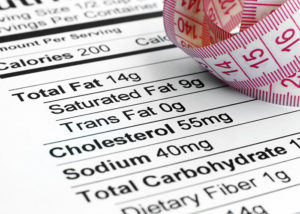 There is some new debate over how many calories you have to burn, to burn a pound of fat, but traditional wisdom was 3,500. So, the traditional way of thinking was that if you want to lose one pound per week: 3,500 calories/7 days = 500 calories per day deficit. In the above example, the woman would have to limit herself to 1143.7 calories per day. If she wanted to lose 15 lbs it would take 15 weeks. This sounds like a fool proof plan for weight loss! The problem is that it doesn’t work very well for most people. There are a myriad of reasons why, but for starters there’s commitment. Most people (yours truly included), don’t count the calories of everything that passes their nose! There’s also the whole hormone aspect (insulin, testosterone, estrogen ect) and metabolism.
There is some new debate over how many calories you have to burn, to burn a pound of fat, but traditional wisdom was 3,500. So, the traditional way of thinking was that if you want to lose one pound per week: 3,500 calories/7 days = 500 calories per day deficit. In the above example, the woman would have to limit herself to 1143.7 calories per day. If she wanted to lose 15 lbs it would take 15 weeks. This sounds like a fool proof plan for weight loss! The problem is that it doesn’t work very well for most people. There are a myriad of reasons why, but for starters there’s commitment. Most people (yours truly included), don’t count the calories of everything that passes their nose! There’s also the whole hormone aspect (insulin, testosterone, estrogen ect) and metabolism.
Enter the Ketogenic Diet, or keto diet as it is also called! It was originally developed to treat epileptic patients who were non-medication responsive. And in the documentary “The Magic Pill” it is shown to treat Alzheimer/dementia, diabetes, cancer and autism as well as other diseases. As a side effect, the keto diet also produces ra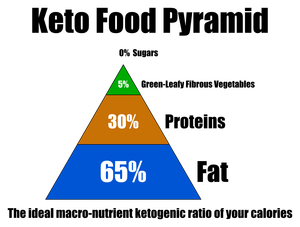 pid weight loss. In the Ketogenic Diet we stop worrying about American agriculture and turn the nutritional pyramid upside down. Your greatest caloric intake should be from healthy fats, followed by meat and fish then green leafy vegetables. Fruit and grain should be consumed VERY sparingly. Your calorie percentages (macros) should break down as follows: 70-75% fat, 20-25% protein and <5% (not to exceed 30 grams per day) carbohydrates. I know what you’re thinking, “Well, now wait a minute… you told me right up there, that when my blood sugar level gets low, my metabolism gets slow and I get tired. Now you’re telling me not to eat the very thing (carbohydrates) that will raise my blood sugar!” Correct, and honestly… the first 3-7 days is going to suck! You will have flu like symptoms (referred to as the keto flu): headache, nausea, constipation, diarrhea and zero energy. The good news is that it only lasts 3-7 days (if you stick to the diet) until you get your body into ketosis. Ketosis is when the liver produces ketones or “ketone bodies” when the body begins breaking down fat due to insufficient carbohydrate intake. It should not be confused with Diabetic Ketoacidosis (or DKA), which is a serious, life threatening condition of type 1 diabetes where there is a high concentration of ketones and glucose in the blood. Ketoacidosis occurs in Type 1 Diabetic people whose bodies can’t produce insulin. Ketosis is where the blood glucose and insulin levels are low and happens naturally to a minor degree to everyone, when they fast, sleep, or starve and is in no way harmful to the body. In fact we are discovering an increasing number of positive health effects from ketosis.
pid weight loss. In the Ketogenic Diet we stop worrying about American agriculture and turn the nutritional pyramid upside down. Your greatest caloric intake should be from healthy fats, followed by meat and fish then green leafy vegetables. Fruit and grain should be consumed VERY sparingly. Your calorie percentages (macros) should break down as follows: 70-75% fat, 20-25% protein and <5% (not to exceed 30 grams per day) carbohydrates. I know what you’re thinking, “Well, now wait a minute… you told me right up there, that when my blood sugar level gets low, my metabolism gets slow and I get tired. Now you’re telling me not to eat the very thing (carbohydrates) that will raise my blood sugar!” Correct, and honestly… the first 3-7 days is going to suck! You will have flu like symptoms (referred to as the keto flu): headache, nausea, constipation, diarrhea and zero energy. The good news is that it only lasts 3-7 days (if you stick to the diet) until you get your body into ketosis. Ketosis is when the liver produces ketones or “ketone bodies” when the body begins breaking down fat due to insufficient carbohydrate intake. It should not be confused with Diabetic Ketoacidosis (or DKA), which is a serious, life threatening condition of type 1 diabetes where there is a high concentration of ketones and glucose in the blood. Ketoacidosis occurs in Type 1 Diabetic people whose bodies can’t produce insulin. Ketosis is where the blood glucose and insulin levels are low and happens naturally to a minor degree to everyone, when they fast, sleep, or starve and is in no way harmful to the body. In fact we are discovering an increasing number of positive health effects from ketosis.
Another sticking point for people is counting calories as mentioned above, now I’m talking about macros and percentages… Okay, you lost me… too much counting… I’m out! But, if you can keep a running tally in your head that never goes over 30, you can do this diet! Because let me tell you, I’m the w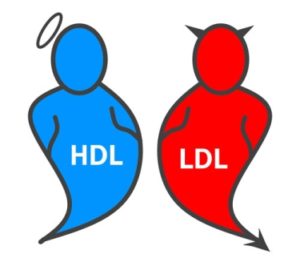 orld’s laziest dieter! The only thing I even remotely count (and its more of a general estimation) is grams of carbs. I eat when I’m hungry, but I don’t eat anything that is over 5 net grams of carbs (more on that later) per serving. I drink water (sometimes flavored 0 calorie) or coffee (either black or bullet), tea is okay too, but I live in the south and if I drink tea, it’s going to be sweet tea… so I had to give that up. To be honest, when I started this, I read the label of everything! If it didn’t have more fat than protein, and/or less than a few grams of carbs, back it went. I made a lot of mistakes in the beginning, and you will too! It’s normal when you’re doing something new. For one thing, I ate a lot of processed food. Do yourself and your doctor a favor and don’t do that. Eating the wrong kinds of fats and oils can increase your cholesterol. However, this diet done properly will increase (HDL) the good cholesterol and decrease (LDL) the bad cholesterol. Because carbohydrates and grain based oils are the primary cause of increasing (LDL).
orld’s laziest dieter! The only thing I even remotely count (and its more of a general estimation) is grams of carbs. I eat when I’m hungry, but I don’t eat anything that is over 5 net grams of carbs (more on that later) per serving. I drink water (sometimes flavored 0 calorie) or coffee (either black or bullet), tea is okay too, but I live in the south and if I drink tea, it’s going to be sweet tea… so I had to give that up. To be honest, when I started this, I read the label of everything! If it didn’t have more fat than protein, and/or less than a few grams of carbs, back it went. I made a lot of mistakes in the beginning, and you will too! It’s normal when you’re doing something new. For one thing, I ate a lot of processed food. Do yourself and your doctor a favor and don’t do that. Eating the wrong kinds of fats and oils can increase your cholesterol. However, this diet done properly will increase (HDL) the good cholesterol and decrease (LDL) the bad cholesterol. Because carbohydrates and grain based oils are the primary cause of increasing (LDL).
How do you feel in ketosis? AMAZING! It’s like this cloud lifts from your mind and mental acuity is increased exponentially. You are full of energy, in fact there are times I have to force myself to shut down and sleep. I’m rarely hungry, and when I am it’s never the h-angry that I used to get. Its not uncommon for me to go 18-24 hours without eating, not because I’m starving myself, but because with my increased energy level, I get busy, I’m not hungry and forget that I haven’t eaten. 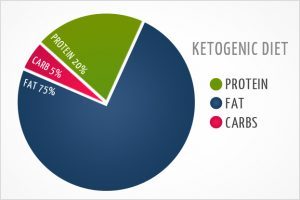 The object of the ketogenic diet is to remain in ketosis for as long as possible.
The object of the ketogenic diet is to remain in ketosis for as long as possible.
What will knock you out of ketosis? Eating (or drinking) too many carbs is the number one way to knock yourself out. Another way is eating too much protein. When you eat too much protein and not enough fat, your body can enter a state of gluconeogenesis (or GNG). This is where the body uses the amino acids in the protein to produce its own glucose because its not getting enough carbohydrates or fats to fuel it. In short there’s a surplus of fuel, just the wrong kind of fuel so the body will use what it has to produce the type of fuel that it can burn and store the easiest and most efficiently.
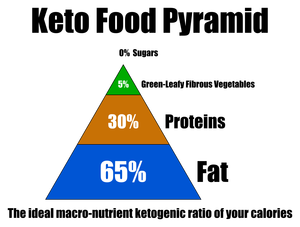
Awesome post! Keep up the great work! 🙂
Great content! Super high-quality! Keep it up! 🙂